Digital product delivery is shifting from large-scale initiatives to smaller, continuous releases. However, many organizations still operate with legacy project structures that struggle to keep pace with today’s rapidly evolving IT landscape. Product teams may be effective in isolation, but their efforts are often disconnected from the needs of the organization. This blueprint will help you scale digital product delivery by organizing products into operationally aligned families that are directly tied to organizational strategy.
Though the need for agility is increasing, most product teams face challenges due to fragmented ownership, unclear priorities, and poor alignment with strategic goals. To meet evolving organizational needs, product leaders must move beyond team-level success and organize delivery around product families to enable coordination, alignment, and value delivery at scale.
1. See the forest and the trees.
Don’t get stuck at the product level. To ensure your products support organizational goals, you must take an enterprise view and organize delivery around clearly defined product families – not individual products. This structure will align product managers’ efforts with organizational strategy and empower product owners to drive focused, measurable impact.
2. Make sure your products do what you need them to.
A well-defined product hierarchy can turn abstract goals into tangible delivery outcomes. By linking product-level capabilities to overall strategic priorities, organizations can steer development efforts with greater clarity and confidence.
3. Put product owners in charge.
Despite their central importance, product owners’ roles remain poorly defined – they are often treated as simple task managers when they should be empowered as strategic leaders. With the right support, they can serve as the bridge between customer needs, operational realities, and delivery teams to ensure continuous value generation.
Use this step-by-step blueprint to align product delivery with organizational goals
Our step-by-step research offers multiphased guidance along with workbooks, templates, and other tools to realign your product structure with your organizational strategy. Use this practical, hands-on approach to scale digital delivery and embed organizational value into every product decision.
- Become a product-centric organization by understanding the organizational factors driving product-centric delivery and establishing a product inventory.
- Organize your products into product families by defining your scaling goals and mapping out your product family areas.
- Ensure alignment between products and families by leveraging and configuring product family roadmaps and managing stakeholders.
- Establish effective product governance by setting target maturity levels, clarifying accountability, identifying your governance operating model, and defining what governance success looks like.
- Bridge the gap between product families and delivery by assessing delivery readiness and options and determining how delivery is to be funded.
- Build your transformation roadmap and communication plan by introducing your digital product family strategy to key stakeholders.
Member Testimonials
After each Info-Tech experience, we ask our members to quantify the real-time savings, monetary impact, and project improvements our research helped them achieve. See our top member experiences for this blueprint and what our clients have to say.
9.3/10
Overall Impact
$68,314
Average $ Saved
50
Average Days Saved
Client
Experience
Impact
$ Saved
Days Saved
The University Of Manchester
Guided Implementation
10/10
$101K
23
Hans is knowledgeable and experienced with a deep understanding of product management and wider digital transformation strategies. The best part of... Read More
Treasury Board of Canada Secretariat - Data and Digital Policy Sector
Guided Implementation
10/10
$50,000
100
You covered the material I needed introduced. Everything you brought up in the call was helpful. I especially like the flexibility to working on st... Read More
Ecco
Guided Implementation
8/10
N/A
1
Medical Protection Society
Guided Implementation
7/10
$85,500
50
All good. We need to do more prep on topics of interest at out side to get the most out of this valuable service.
Canada School of Public Service
Guided Implementation
10/10
$1,500
3
Alfred H. Knight Holding
Guided Implementation
10/10
$171K
120
Hans is great. The materials and advice gives us a head start and ensures we're right on track. Going off track on expensive projects can be.... ex... Read More
CGIAR
Workshop
10/10
N/A
50
great value workshop and amazing facilitator
Utah Valley University
Guided Implementation
10/10
$32,499
20
Hans did an amazing job both answering the ad hoc questions and ensuring we got through the material we NEEDED to receive to meet our goals for the... Read More
X4 Pharmaceuticals
Guided Implementation
10/10
$62,999
20
Workshop: Deliver Digital Products at Scale
Workshops offer an easy way to accelerate your project. If you are unable to do the project yourself, and a Guided Implementation isn't enough, we offer low-cost delivery of our project workshops. We take you through every phase of your project and ensure that you have a roadmap in place to complete your project successfully.
Module 1: Become a Product-Centric Organization
The Purpose
- Define products in your organization’s context and explore product families as a way to organize products at scale.
Key Benefits Achieved
- An understanding of the case for product practices
- A concise definition of products and product families
Activities
Outputs
Understand your organizational factors driving product-centric delivery.
- Organizational drivers and goals for a product-centric delivery
Establish your organization’s product inventory.
- Definition of product
Determine your approach to scale product families.
- Product scaling principles
Define your product families
- Scaling approach and direction Pilot list of products to scale
Module 2: Ensure Alignment Between Products and Families
The Purpose
To strengthen product family roadmap communication and alignment through stakeholder engagement and clear value definition.
Key Benefits Achieved
- Improved stakeholder communication through a structured engagement plan.
- Clear, consistent product family roadmaps that reflect business value.
- Stronger alignment between individual products and their product families.
Activities
Outputs
Leverage product family roadmaps
- Current approach for communication of product family strategy
Use stakeholder management to improve roadmap communication
- List of product family stakeholders and a prioritization plan for communication
Configure your product family roadmaps
- Defined key pieces of a product family roadmap
Confirm product family to product alignment
- An approach to confirming alignment between products and product families through a shared definition of business value
Module 3: Establish Effective Product Governance
The Purpose
This phase enables your organization to align on a shared definition of product governance, assess current and target maturity levels, and understand the key tasks and risks associated with advancing. It clarifies roles, responsibilities, and accountability to ensure strong ownership of product governance. Additionally, it helps you discover your product governance operating model and establish success metrics grounded in both qualitative and quantitative measures.
Key Benefits Achieved
- Achieve organizational alignment on a shared and clear definition of product governance.
- Gain insight into current and target maturity levels to guide improvement efforts.
- Clarify roles, responsibilities, and accountability to strengthen ownership of product governance activities.
- Identify your best-fit product governance operating model.
- Identify the right success metrics to measure progress.
Activities
Outputs
Define product governance
- Alignment on what product governance means for your organization
Understand your current and target maturity level
- Your baseline and target maturity levels
Clarify accountability
- Your team's roles and accountability
Identify your product governance operating model
- Understand your operating model for product governance
Define product governance success
- Identify your product governance success metrics
Module 4: Bridge the Gap Between Product Families and Delivery
The Purpose
Define how your organization will deliver product families by assessing readiness, selecting a delivery model, and planning communication and next steps.
Key Benefits Achieved
- Clear operating and delivery model aligned to your organization’s maturity
- Defined roadmap and funding approach to guide transformation
- Structured communication plan and next steps to launch the strategy
Activities
Outputs
Assess your organization’s delivery readiness
- Assessment results on your organization’s delivery maturity
Understand your delivery options
- A preferred approach to structuring product delivery
Determine your operating model
- Your preferred operating model for delivering product families
Identify how to fund product delivery
Learn how to introduce your digital product family strategy
- Product family transformation roadmap
Communicate changes on updates to your strategy.
- Your plan for communicating your roadmap
Determine your next steps
- List of actionable next steps to start on your journey
Module 5: Advisory: Next Steps and Follow-Up (post-workshop)
The Purpose
Advance the product family operating model through communication, pilot evaluation, and targeted support.
Key Benefits Achieved
- Clear organizational understanding of product families and roadmaps
- Refined transformation roadmap based on pilot insights
- Targeted support to strengthen product ownership and planning
Activities
Outputs
Execute communication plan and product family changes
- Organizational communication of product families and product family roadmaps
Review the pilot family implementation and update the transformation roadmap
- Product family implementation and updated transformation roadmap
Begin advisory calls for related blueprints
- Support for product owners, backlog and roadmap management, and other topics
Deliver Digital Products at Scale
Deliver value at the scale of your organization through defining enterprise product families.
Analyst Perspective
Product families align enterprise goals to product changes and value realization.
 |
 |
 |
 |
Our world is changing faster than ever, and the need for business agility continues to grow. Organizations are shifting from long-term project delivery to smaller, iterative product delivery models to be able to embrace change and respond to challenges and opportunities faster.
Unfortunately, many organizations focus on product delivery at the tactical level. Product teams may be individually successful, but how well are their changes aligned to division and enterprise goals and priorities?
Grouping products into operationally aligned families is key to delivering the right value to the right stakeholders at the right time.
Product families translate enterprise goals, constraints, and priorities down to the individual product level so product owners can make better decisions and more effectively manage their roadmaps and backlogs. By scaling products into families and using product family roadmaps to align product roadmaps, product owners can deliver the capabilities that allow organizations to reach their goals.
In this blueprint, we’ll provide the tools and guidance to help you define what “product” means to your organization, use scaling patterns to build product families, align product and product family roadmaps, and identify impacts to your delivery and organizational design models.
Banu Raghuraman, Ari Glaizel, Hans Eckman, and Pooja Khandelwal
Applications Practice
Info-Tech Research Group
Deliver Digital Products at Scale
Deliver value at the scale of your organization through defining enterprise product families.
EXECUTIVE BRIEF
Executive summary
Your Challenge |
Common Obstacles |
Info-Tech’s Approach |
|---|---|---|
|
|
Info-Tech’s approach will guide you through:
|
Info-Tech Insight
Changes can only be made at the individual product or service level. To achieve enterprise goals and priorities, organizations need to organize and scale products into operational families. This structure allows product managers to translate goals and constraints to the product level and allows product owners to deliver changes that support enabling capabilities. In this blueprint, we’ll help you define your products, scale them using the best patterns, and align your roadmaps and delivery models to improve throughput and value delivery.
Your product transformation journey
1. Make the Case for Product Delivery
Align your organization with the practices to deliver what matters most
2. Lead and Manage Product Owners
One-day executive workshop: Align and prepare your leadership
3. Deliver on Your Digital Product Vision
Enhance product backlogs, roadmapping, and strategic alignment
4. Deliver Digital Products at Scale - We are here
Scale product families to align enterprise goals
5. Mature and Scale Product Ownership
Assess and develop your product owners
Info-Tech’s approach
Operationally align product delivery to enterprise goals.

The Info-Tech difference:
- Start by piloting product families to determine which approaches work best for your organization.
- Create a common definition of what a product is and identify products in your inventory.
- Use scaling patterns to build operationally aligned product families.
- Develop a roadmap strategy to align families and products to enterprise goals and priorities.
- Use products and families to evaluate delivery and organizational design improvements.

Product does not mean the same thing to everyone
Do not expect a universal definition of products.
Every organization and industry has a different definition of what a product is. Organizations structure their people, processes, and technologies according to their definition of the products they manage. Conflicting product definitions between teams increase confusion and misalignment of product roadmaps.
“A product [is] something (physical or not) that is created through a process and that provides benefits to a market.”
– Mike Cohn, Founding Member of Agile Alliance and Scrum Alliance
“A product is something ... that is created and then made available to customers, usually with a distinct name or order number.”
– TechTarget
“A product is the physical object ... , software or service from which customer gets direct utility plus a number of other factors, services, and perceptions that make the product useful, desirable [and] convenient.”
– Mark Curphey
Organizations need a common understanding of what a product is and how it pertains to the business.
This understanding needs to be accepted across the organization.
“There is not a lot of guidance in the industry on how to define [products]. This is dangerous because what will happen is that product backlogs will be formed in too many areas. All that does is create dependencies and coordination across teams … and backlogs.”
– Chad Beier, "How Do You Define a Product?”, Scrum.org
What is a product?
“A tangible solution, tool, or service (physical or digital) that enables the long-term and evolving delivery of value to customers and stakeholders based on business and user requirements.”
Info-Tech Insight
A proper definition of product recognizes three key facts:
- Products are long-term endeavors that don’t end after the project finishes.
- Products are not just “apps” but can be software or services that drive the delivery of value.
- There is more than one stakeholder group that derives value from the product or service.
Products and services share the same foundation and best practices
For the purpose of this blueprint, product/service and product owner/service owner are used interchangeably. Product is used for consistency but would apply to services as well.
Product = Service
“Product” and “service” are terms that each organization needs to define to fit its culture and customers (internal and external). The most important aspect is consistent use and understanding of:
- External products
- Internal products
- External services
- Internal services
- Products as a service (PaaS)
- Productizing services (SaaS)
Recognize the different product owner perspectives
Technical
IT systems and tools
Business
Customer facing, revenue generating
Operations
Keep the lights on processes
Info-Tech Best Practice
Product owners must translate needs and constraints from their perspective into the language of their audience. Kathy Borneman, Digital Product Owner at SunTrust Bank, noted the challenges of finding a common language between lines of business and IT (e.g. what is a unit?).
Info-Tech Insight
Recognize that product owners represent one of three primary perspectives. Although all share the same capabilities, how they approach their responsibilities is influenced by their perspective.
“A Product Owner in its most beneficial form acts like an Entrepreneur, like a 'mini-CEO'. The Product Owner is someone who really 'owns' the product.”
– Robbin Schuurman,
“Tips for Starting Product Owners”
Identify the differences between a project-centric and a product-centric organization
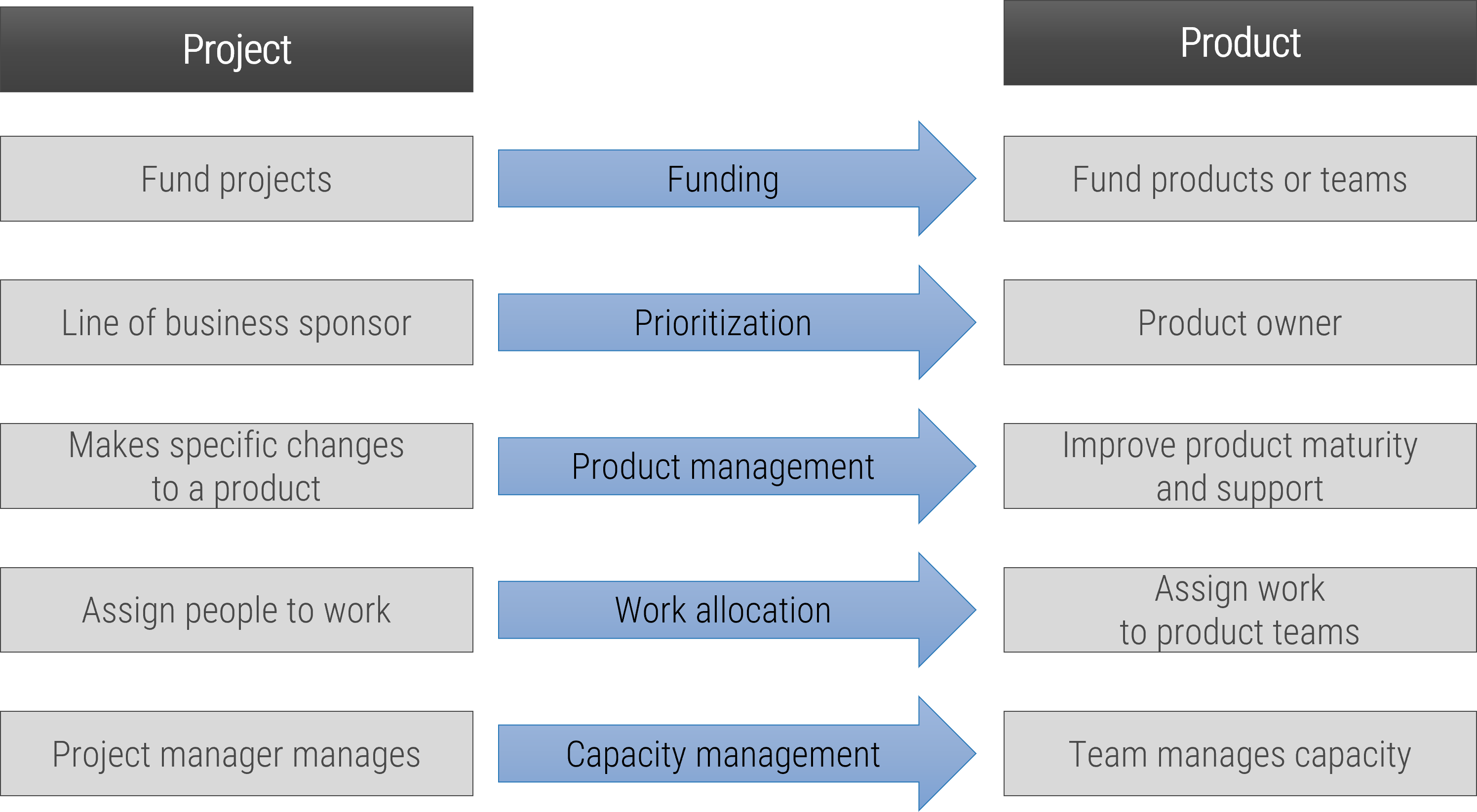
Info-Tech Insight
Product delivery requires significant shifts in the way you complete development work and deliver value to your users. Make the changes that support improving end-user value and enterprise alignment.
Projects can be a mechanism for delivering product changes and improvements
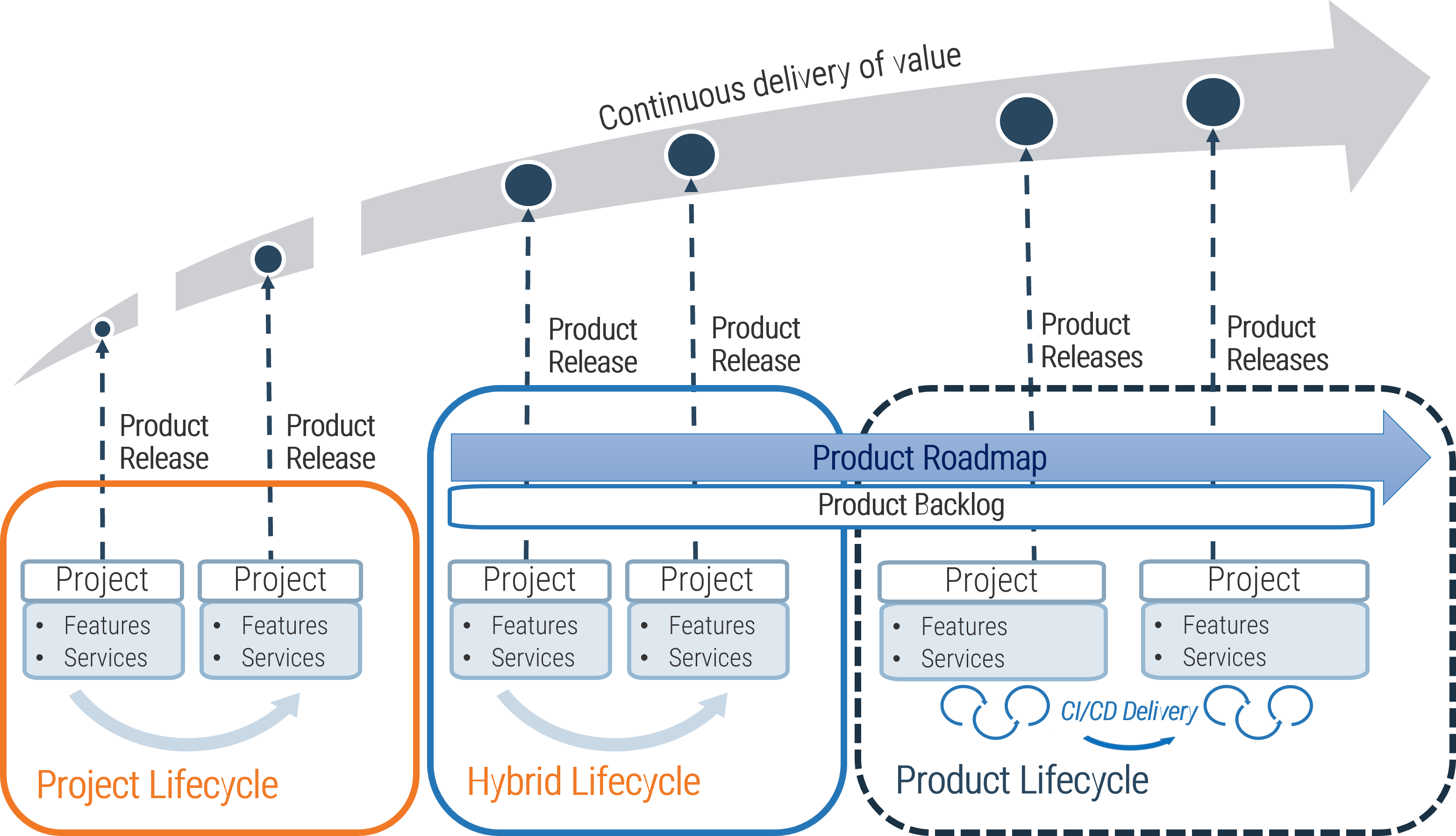
Projects within products
Regardless of whether you recognize yourself as a product-based or project-based shop, the same basic principles should apply.
The purpose of projects is to deliver the scope of a product release. The shift to product delivery leverages a product roadmap and backlog as the mechanism for defining and managing the scope of the release.
Eventually, teams progress to continuous integration/continuous delivery (CI/CD) where they can release on demand or as scheduled, requiring org change management.
Define product value by aligning backlog delivery with roadmap goals
In each product plan, the backlogs show what you will deliver. Roadmaps identify when and in what order you will deliver value, capabilities, and goals.

Product roadmaps guide delivery and communicate your strategy
In Deliver on Your Digital Product Vision, we demonstrate how the product roadmap is core to value realization. The product roadmap is your communicated path, and as a product owner, you use it to align teams and changes to your defined goals while aligning your product to enterprise goals and strategy.

Info-Tech Insight
The quality of your product backlog – and your ability to realize business value from your delivery pipeline – is directly related to the input, content, and prioritization of items in your product roadmap.
Use Agile DevOps principles to expedite product-centric delivery and management
Delivering products does not necessarily require an Agile DevOps mindset. However, Agile methods facilitate the journey because product thinking is baked into them.
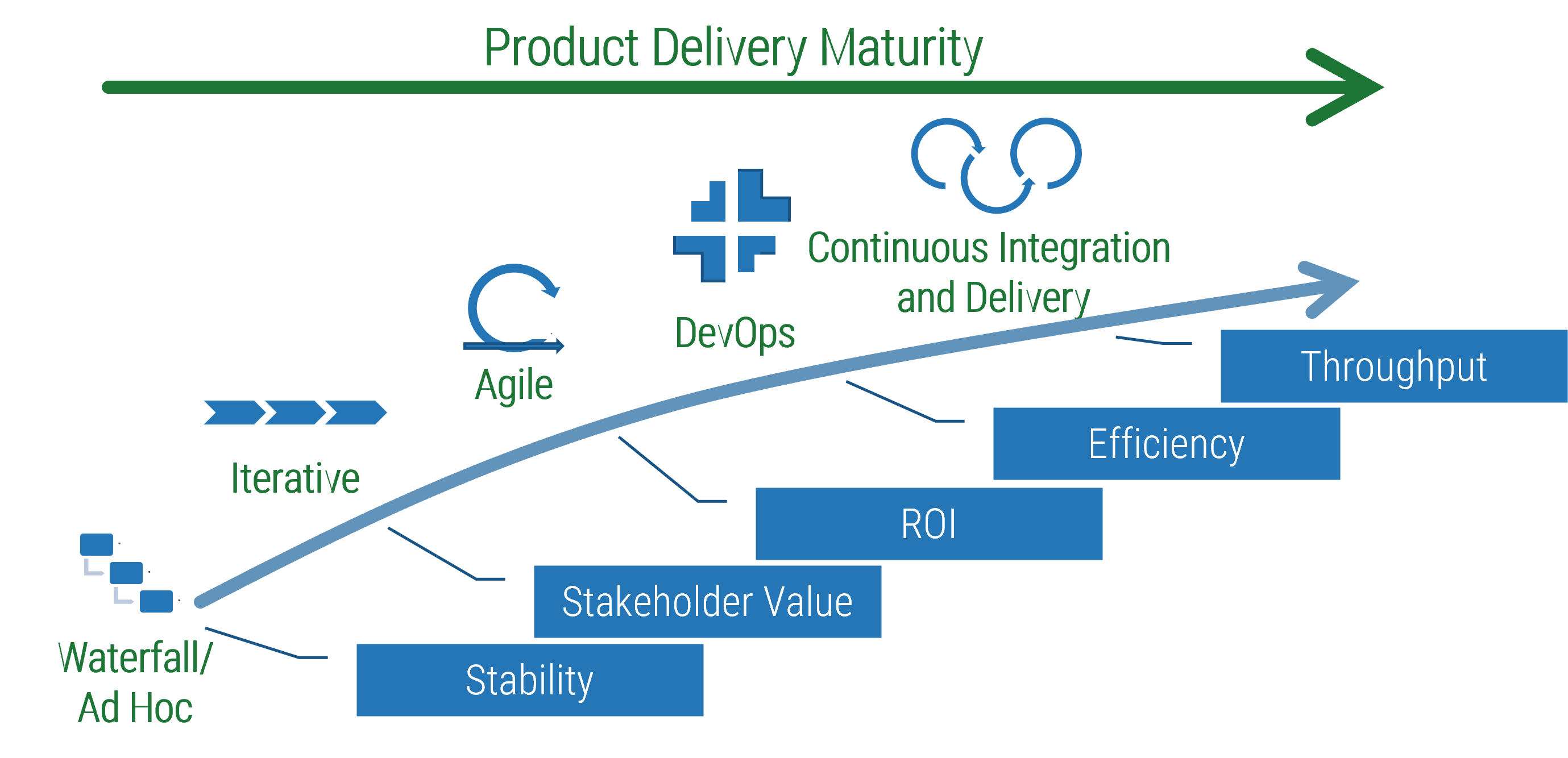
Based on: Ambysoft, 2018
Organizations start with Waterfall to improve the predictable delivery of product features.
Iterative development shifts the focus from delivery of features to delivery of user value.
Agile further shifts delivery to consider ROI. Often, the highest-value backlog items aren’t the ones with the highest ROI.
Lean and DevOps improve your delivery pipeline by providing full integration between product owners, development teams, and operations.
CI/CD reduces time in process by allowing release on demand and simplifying release and support activities.
Although teams will adopt parts of all these stages during their journey, it isn’t until you’ve adopted a fully integrated delivery chain that you’ve become product-centric.
Scale products into related families to improve value delivery and alignment
Defining product families builds a network of related products into coordinated value delivery streams.
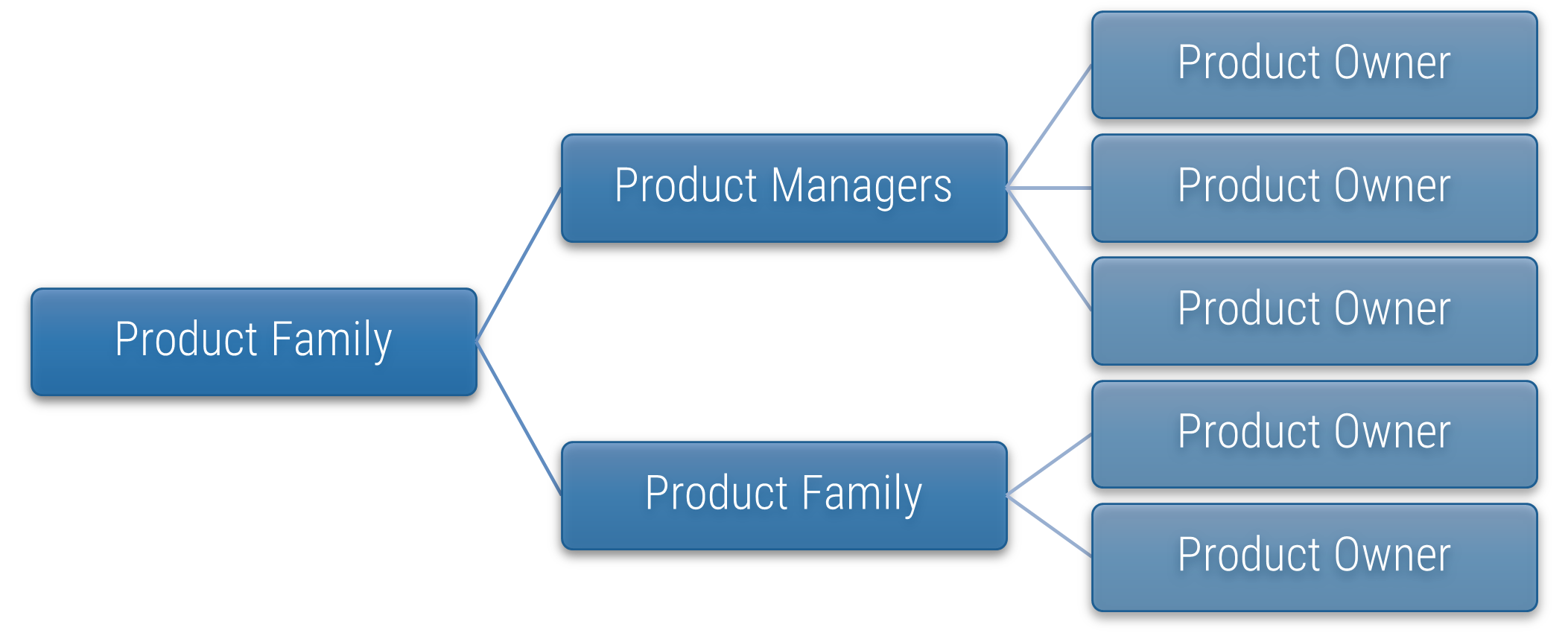
“As with basic product management, scaling an organization is all about articulating the vision and communicating it effectively. Using a well-defined framework helps you align the growth of your organization with that of the company. In fact, how the product organization is structured is very helpful in driving the vision of what you as a product company are going to do.”
– Rich Mironov, Mironov Consulting
Product families translate enterprise goals into value-enabling capabilities
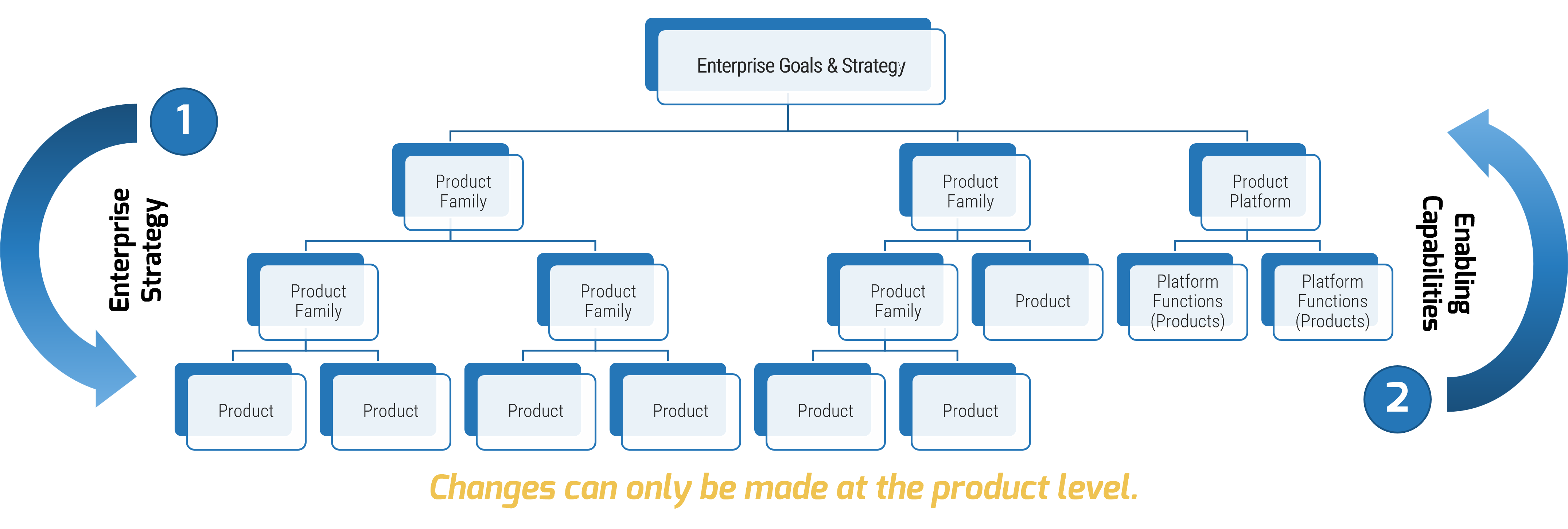
Info-Tech Insight
Your organizational goals and strategy are achieved through capabilities that deliver value. Your product hierarchy is the mechanism to translate enterprise goals, priorities, and constraints down to the product level where changes can be made.
Arrange product families by operational groups, not solely by your org chart
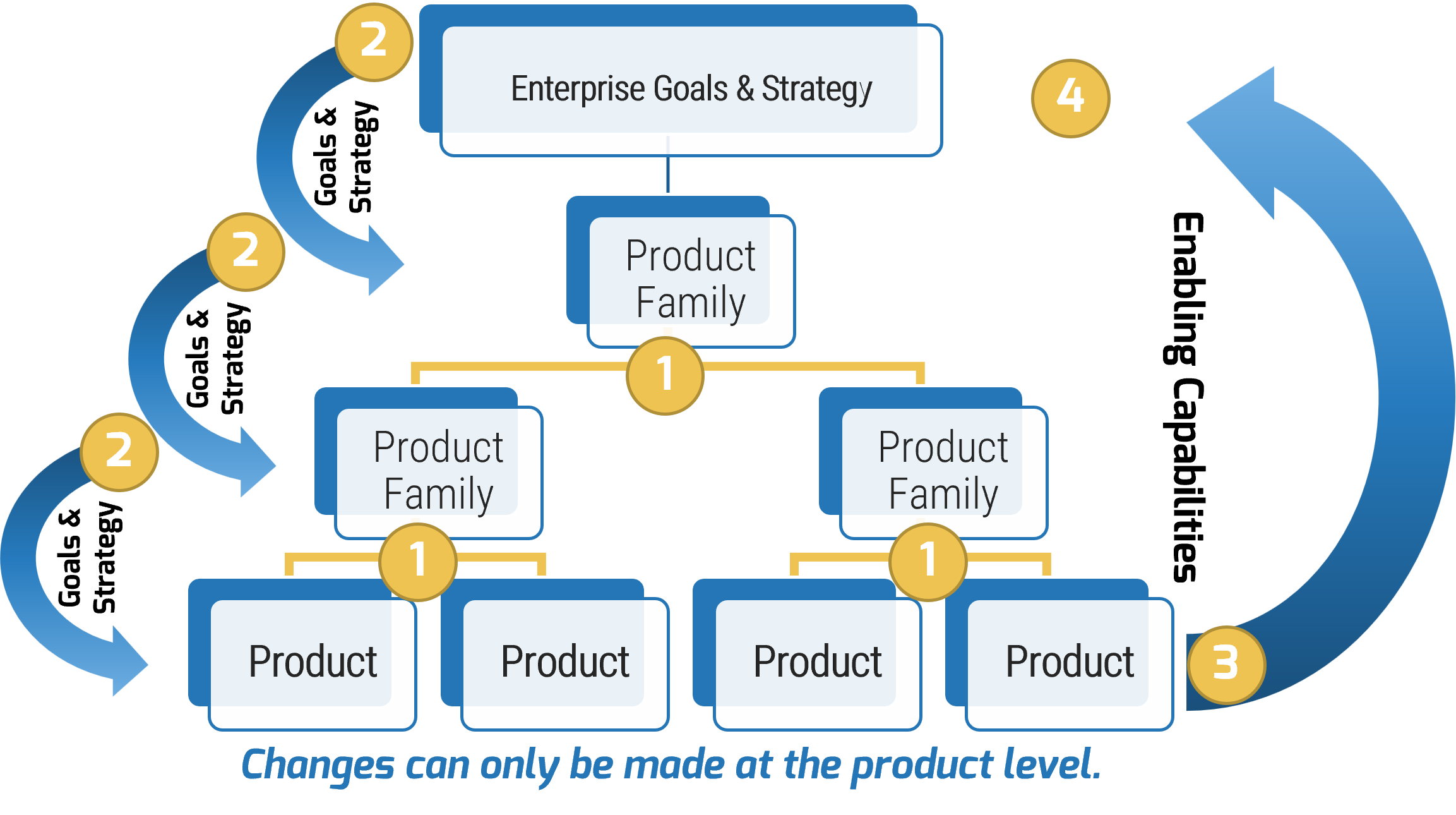
Leverage patterns for scaling products
Organizing your products and families is easier when leveraging these grouping patterns.
Value Stream Alignment |
Enterprise Applications |
Shared Services |
Technical |
Organizational Alignment |
|---|---|---|---|---|
|
|
|
|
|

 Mature and Scale Product Ownership
Mature and Scale Product Ownership
 Evolve Your Software Development Lifecycle Into a Solution Delivery Lifecycle
Evolve Your Software Development Lifecycle Into a Solution Delivery Lifecycle
 Adopt Generative AI in Solution Delivery
Adopt Generative AI in Solution Delivery
 Boost Solution Delivery Throughput With AI
Boost Solution Delivery Throughput With AI
 Estimate Software Delivery With Confidence
Estimate Software Delivery With Confidence
 Select and Use SDLC Metrics Effectively
Select and Use SDLC Metrics Effectively
 Improve Application Development Throughput
Improve Application Development Throughput
 Activate Your Augmented Reality Initiative
Activate Your Augmented Reality Initiative
 Spread Best Practices With an Agile Center of Excellence
Spread Best Practices With an Agile Center of Excellence
 Perform an Agile Skills Assessment
Perform an Agile Skills Assessment
 Deliver on Your Digital Product Vision
Deliver on Your Digital Product Vision
 Mentoring for Agile Teams
Mentoring for Agile Teams
 Implement DevOps Practices That Work
Implement DevOps Practices That Work
 Deliver Digital Products at Scale
Deliver Digital Products at Scale
 Enhance Your Solution Architecture Practices
Enhance Your Solution Architecture Practices
 Define a Release Management Process to Deliver Lasting Value
Define a Release Management Process to Deliver Lasting Value
 2020 Applications Priorities Report
2020 Applications Priorities Report
 Agile Readiness Assessment Survey
Agile Readiness Assessment Survey
 Define a Sourcing Strategy for Your Development Team
Define a Sourcing Strategy for Your Development Team
 Define the Role of Project Management in Agile and Product-Centric Delivery
Define the Role of Project Management in Agile and Product-Centric Delivery
 Implement a Transformative IVR Experience That Empowers Your Customers
Implement a Transformative IVR Experience That Empowers Your Customers
 Create an Agile-Friendly Project Gating and Governance Approach
Create an Agile-Friendly Project Gating and Governance Approach
 Develop Your Agile Approach for a Successful Transformation
Develop Your Agile Approach for a Successful Transformation
 Take the First Steps to Embrace Open-Source Software
Take the First Steps to Embrace Open-Source Software
 Enable Product Delivery – Executive Leadership Workshop
Enable Product Delivery – Executive Leadership Workshop